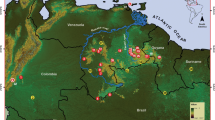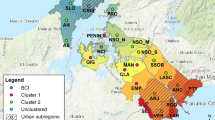By comparing geographical patterns of old and new species with historical and ecological processes, interpretations can be made about time patterns of diversification. Such interpretations can form a basis for developing rationales for ranking biodiversity conservation priorities. The results of the comprehensive study of avian DNA were used to compare geographical distributions in Africa and South America of species of strong Plio-Pleistocene radiations and species representing older monophyletic branches. Striking patterns, some of them overlooked so far, were found. Most old species are widespread across a physiognomic and climatic domain, such as lowland rainforests, and therefore, are not specific conservation targets. In contrast, new species have evolved in well defined places with a special local environment, in particular in ecologically equable places inside geologically complex ecotonal regions. High species richness and taxonomic diversity, where maintained over wide areas by steady habitat alteration through patch dynamics, may be easiest to protect by general reforms that integrate regional development and protection of ecosystem services, rather than by strictly site-oriented projects. Areas of active speciation, although small, may have important regulatory functions and a critical role for maintaining evolutionary fronts'. The Tropical Andes Region includes a dozen such places. There is a congruence between the occurrence of old species which have relictual distributions and aggregates of limited-range component species of recent vicariance patterns, indicating that vicariance events take place mainly by isolation in extremely ecologically stable areas. Although these places do not necessarily have the highest taxic diversity, they should be top priorities for rapid and concentrated conservation action.
Similar content being viewed by others
References
Adamoli, J., Sennhauser, E.B., Acero, J.M. and Rescia, A. (1990) Stress and disturbance: vegetation dynamics in the dry chaco region of Argentina. J. Biogeo. 17, 491–500.
Amorim, D.S. (1991) Refuge model simulations: testing the theory. Revia Bras. Ent. 35, 803–12.
Arctander, P. and Fjeldså, J. (In press) Andean tapaculos of the genus Scytalopus (Aves, Rhinocryptidae), a study of models of differentiation, using DNA sequence data. In Molecular biology and conservation (V. Loeschcke, J. Tomiuk and S. Jain, eds) Basel Birkhäuser, EXS-series.
Axelrod, D.I. and Raven, P.H. (1978) Late cretaceous and tertiary vegetation history of Africa. In Biogeography and ecology of southern Africa (M.J.A. Werger, ed.) 77–130. The Hague: Dr. W. Junk Publ.
Ayres, J.M. and Clutton, T.H. (1992) River boundaries and species range size in Amazonian primates. Am. Nat. 140, 531–7.
Brooks, D.R., Mayden, R.L. and McLennan, D.A. (1992) Phylogeny and biodiversity: conserving our evolutionary legacy. Tree 7, 55–9.
Caparella, A.P. (1991) Neotropical avian diversity and riverine barriers. Acta XX Congr. Int. Orn. 307–16.
Cole, M.M. (1986) The savannas. London: Academic Press.
Connell, J.H. (1978) Diversity in tropical rain forest and coral reefs. Science 199, 1302–10.
Crowe, T.M. and Crowe, A.A. (1982) Patterns of distribution, diversity and endemism in Afrotropical birds. J. Zool. 198, 417–42.
Crowe, T.M. and Kemp, A.C. (1988) African historical biogeography as reflected by galliform and hornbill evolution. Acta XIX Congr. Int. Orn. 2510–8.
Diamond, A.W. and Hamilton, A.C. (1980) The distribution of forest passerine birds and quaternary climatic change in tropical Africa. J. Zool. (London) 191, 379–402.
Diamond, A.W. (1985) The selection of critical areas and current conservation efforts in tropical forest birds. In Conservation of tropical forest birds (A. Diamond and T.E. Lovejoy, eds) pp. 22–48. Cambridge, UK: ICBP Technical Publ. 4. ICBP.
Diamond, J. (1984) Biogeographic mosaics in the Pacific. In Biogeography of the Tropical Pacific (F.J. Radowsky, P.H. Raven and S.H. Sohmer, eds) pp. 1–14. Lawrence, Kansas: Ass. Syst. Coll.
Dinesen, L., Lehmberg, T., Svendsen, J.O., Hansen, L.A. and Fjeldså, J. (1994) A new genus and species of perdicine bird (Phasianidae, Perdicini) from Tanzania, a relict form with Indo-Malayan affinities. Ibis.
Eldredge, N. (ed.) (1992) Systematics, ecology, and the biodiversity crisis. New York: Columbia University Press.
Erwin, T.L. (1991) An evolutionary basis for conservation strategies. Science 253, 750–2.
Faith, D.P. (1992) Conservation evaluation and phylogenetic diversity. Biol. Conserv. 61, 1–10.
Fjeldså, J. (1992) Biogeographic patterns and evolution of the avifauna of the relict high-altitude woodlands of the Andes. Steenstrupia 18, 9–62.
Fjeldså, J. (In press) Geographical patterns of neoendemic and relict species of Andean forest birds: the significance of ecological stability areas. Mem. New York Bot. Gard.
Fjeldså, J. (1994) The avifauna of Polylepis woodlands of the Andean highlands: conservation priorities based on patterns of endemism. Bird Conserv. Int. 3, 37–55.
Fjeldså, J. and Krabbe, N. (1990) Birds of the High Andes. Zoological Museum, Copenhagen, and Apollo Books, Svendborg.
Gentry, A.H. (1986) Endemism in tropical yersus temperate plant communities. In Conservation Biology (M.E. Soule, ed.) pp. 153–61. Sunderland, Mass: Sinauer Ass.
Griffiths, C.J. (In press) The geological evolution of East Africa. In The biogeography and ecology of the rainforests of eastern Africa (J.C. Lovett and S.K. Wasser, eds). Cambridge: Cambridge University Press.
Groombridge, B. (Ed.) (1992) Global biodiversity. Status of the earth's living resources. London: World Conservation Monitoring Centre-Chapman & Hall.
Haffer, J. (1974) Avian speciation in tropical South America. Publ. Nuttal Orn. Club 14, 1–390.
Haffer, J. (1993) Time's cycle and time's arrow in the history of Amazonia. Biogeog. 69, 15–45.
Hamilton, A.C. (1982) Environmental history of East Africa. A study of the Quaternary. London: Academic Press.
Hamilton, A.C. (1988) Guenon evolution and forest history. In Primate radiation: evolutionary biology of the African guenons (A. Gautier, F. Baulier, J.P. Gautier and J. Kingdom, eds) pp. 13–34. Cambridge, UK: Cambridge University Press.
Hooghiemstra, H. (1991) Long continental pollen record from a tropical intermontane basin; Late Pliocene and Pleistocene history from a 540-meter core. Episodes 14, 107–15.
Holbech, L.H. (1992) Effects of selective logging on a rain-forest bird community in western Ghana. Thesis, University of Copenhagen, Denmark.
Holdridge, L.R. (1967) Life zone ecology. San Jose, Costa Rica: Tropical Science Centre.
ICBP (1992) Putting biodiversity on the map: global priorities for conservation. Cambridge, UK: ICBP.
Jackson, J. (1989) Climate, water and agriculture in the tropics. Harlow: Longman.
Kerfoot, O. (1968) Mist precipitation on vegetation. For. Abstr. 29, 8–20.
Kingdon, J. (1989) Island Africa-the evolution of Africa's rare animals and plants. Princeton, NJ: Princeton University Press.
Klopfer, P.H. and MacArthur, R.H. (1960) Niche size and faunal diversity. Am. Nat. 94, 293–300.
Lanyon, S.M. (1985) Molecular perspective on higher-level relationships in the Tyrannoidea (Aves). Syst. Zool. 34, 404–18.
Lézine, A.-M. and Casanova, J. (1989) Pollen and hydrological evidence for the interpretation of past climates in tropical West Africa during the Holocene. Quat. Sci. Rev. 8, 45–55.
Lovett, J.C. (1992) Classification and status of the Eastern Arc forests of Tanzania. PhD thesis, University College North Wales, UK.
Margules, C.R., Nicholls, A.O. and Pressey, R.L. (1988) Selecting networks of reserves to maximise biological diversity. Biol. Conserv. 43, 63–76.
May, R.M. (1990) Taxonomy as destiny. Nature 347, 129–30.
Mayr, E. and O'Hara, R.J. (1986) The biogeographical evidence supporting the refuge hypothesis. Evolution 40, 55–65.
McNeely, J.A., Miller, K.P., Reid, W.V., Mittermeier, R.A. and Werner, T.B. (1990) Conserving the World's Biological Diversity. Gland, Switzerland: IUCN.
Myers, N. (1990) The biodiversity challenge: expanded hot-spot analysis. Environmentalist 10, 243–56.
O'Hara, R.J. (1991) [Review of] Phylogeny and classification of birds: a study of molecular evolution, by C.G. Sibley and J.E. Ahlquist. Auk 108, 990–4.
Patton, J.L. and Smith, M.F. (1992) Int DNA phylogeny of Andean mice: a test of diversification across ecological gradients. Evolution 46, 174–83.
Petri, S. and Fúlfaro, V.J. (1983) Geologia do Brazil (Fanerozóico). T.A. Queiroz and Editora 071 da Universidade de SaoPaulo, Brazil.
Prell, W.L., Hutson, W.H., Williams, D.R., Bé, A.W.H., Geitzenauer, K. and Molfino, B. (1980) Surface circulation of the Indian Ocean during the last glacial maximum, approximately 18 000 yr B.P. Quaternary Res. 14, 309–36.
Prigogine, A. (1988) Speciation pattern of birds in the Central African Forest Refugia and their relationship with other refugia. Acta XIX Congr. Int. Orn. 2537–46.
Prum, R.O. (1988) Historical relationships among avian forest areas of endemism in the Neotropics. Acta XIX Congr. Int. Orn. 2562–72.
Prum, R.O. (1990) Phylogenetic analysis of the evolution of display behavior in the neotropical manakins (Aves: Pipridae). Ethology 84, 202–31.
Putzer, H. (1984) The geological evolution of the Amazon Basin and its mineral resources. In The Amazon (H. Sioli, ed.) pp. 15–46. Dordrecht: Dr. W. Junk Publ.
Ricklefs, R.E. (1989) Speciation and diversity: the integration of local and regional processes. In Speciation and its consequences (D. Otte and J.A. Endler, eds.) pp. 599–622. Sunderland, Mass: Sinauer Ass.
Salo, J. (1988) Rainforest diversification in the western Amazon basin: the role of river dynamics. Thesis. Rep. Dept. Biol. Univ. Turku 16 (collection of four articles).
Sanford, R.L., Saldarriga, J., Clarke, K.E., Uhl, C. and Herrera, R. (1985) Amazon rain-forest fires. Science 227, 53–5.
Scharff, N. (1992) The linyphiid fauna of eastern Africa (Araneae: Linyphiidae)-distribution patterns, diversity and endemism. Biol. J. Linn. Soc. 45, 117–54.
Seltzer, G.O. (1990) Recent glacial history and paleoclimate of the Peruvian and Bolivian Andes. Quat. Sci. Rev. 9, 137–52.
Sibley, C.G. and Ahlquist, J.E. (1990) Phylogeny and classification of birds. A study in molecular evolution. New Haven-London: Yale University Press.
Snow, D.W. (1973) The classification of the Cotingidae (Aves). Breviora 409, 26 pp.
Sousa, W.P. (1984) Disturbance and patch dynamics on rocky intertidal shores. In Natural disturbance: an evolutionary perspective (T.A. Pickett and P.S. White, eds) Academic Press.
Stebbins, G.L. (1974) Flowering plants. Evolution above the species level. Cambridge, Mass: Belknap Press.
Stenseth, N.C. (1980) Spatial heterogeneity and population stability: some evolutionary consequences. Oikos 35, 165–84.
Stuart, S.N., Jensen, F.P., Brøgger-Jensen, S. and Miller, R.I. (In press). The zoogeography of the montane forest avifauna of eastern Tanzania. In The biogeography and ecology of the rainforests of eastern Africa (J.C. Lovett and S.K. Wasser, eds) Cambridge: Cambridge University Press.
Terborgh, J. and Weske, J.S. (1975) The role of competition in the distribution of Andean birds. Ecol. 56, 562–76.
Valentine, J.W. (1967) The influence of climatic fluctuations on species diversity within the tethyan provincial system. In Aspects of Tethyan biogeography (C.G. Adams and D.V. Ager, eds), pp. 153–166. Systematics Ass. Publ. 7.
van der Hammen, T. (In press) Global change, biodiversity and conservation of Neotropical montane forests. Mem. New York Bot. Gard.
Vane-Wright, R.I., Humphries, C.J. and Williams, P.H. (1991) What to protect?-Systematics and the agony of choice. Biol. Conserv. 55, 235–54.
Vuilleumier, F. (1984) Faunal turnover and development of fossil avifaunas in South America. Evolution 38, 1384–96.
Vuilleumier, F. (1985) Fossil and recent avifaunas and the interamerican interchange. In The great American biotic interchange (F.G. Stehli and S.D. Webb, eds) pp. 387–424. New York: Plenum.
Whitmore, T.C. and Prance, G.T. (eds) (1987) Biogeography and quaternary history in tropical America. Oxford: Clarendon.
Williams, P.H., Humphries, C.J. and Vane-Wright, R.I. (1991) Measuring biodiversity: taxonomic relatedness for conservation priorities. Aust. Syst. Bot. 4, 665–79.
Williams, P.H., Vane-Wright, R.I. and Humphries, C.J. (1993) Measuring biodiversity for choosing conservation areas. In Hymenoptera and biodiversity (J. LaSalle, ed.) pp. 309–28. Wallingford: CABI.
Witting, L. and Loeschcke, V. (In press) Ecological and evolutionary complexity in biodiversity conservation. J. Theor. Biol.
Author information
Authors and Affiliations
Rights and permissions
About this article
Cite this article
Fjeldså, J. Geographical patterns for relict and young species of birds in Africa and South America and implications for conservation priorities. Biodivers Conserv 3, 207–226 (1994). https://doi.org/10.1007/BF00055939
Received:
Accepted:
Issue Date:
DOI: https://doi.org/10.1007/BF00055939




